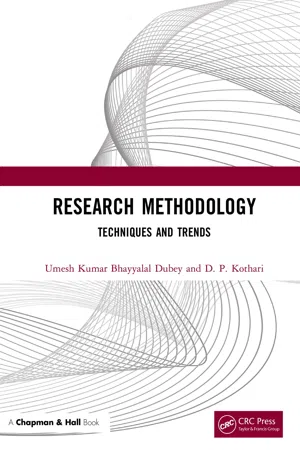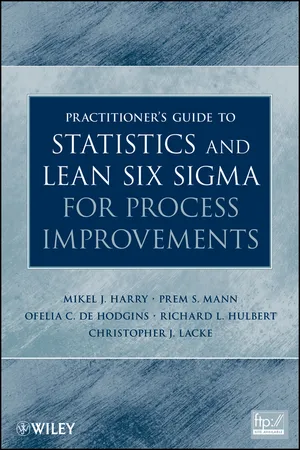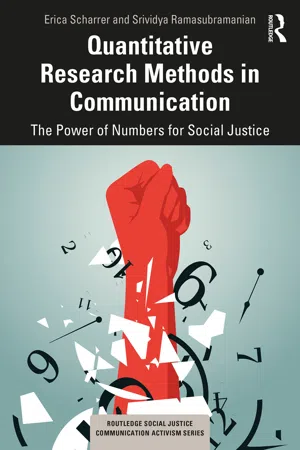Psychology
Sampling Methods
Sampling methods in psychology refer to the techniques used to select a representative group of participants from a larger population for research purposes. Common sampling methods include random sampling, stratified sampling, and convenience sampling. The choice of sampling method can impact the generalizability of study findings to the larger population.
Written by Perlego with AI-assistance
Related key terms
11 Key excerpts on "Sampling Methods"
- eBook - ePub
Dissertation Research Methods
A Step-by-Step Guide to Writing Up Your Research in the Social Sciences
- Philip Adu, D. Anthony Miles(Authors)
- 2023(Publication Date)
- Routledge(Publisher)
Figure 16.1 illustrates the major steps in the sampling process.Source: Adopted from Sekaran and Bougie (2013).Figure 16.1The sampling process.Before choosing a specific type of sampling technique, a broad sampling technique needs to be decided on. One of the difficult aspects of research is launching an experience-sampling study. It can provide a challenge to even the most seasoned researcher (Christensen et al., 2003 ). When a researcher decides to begin the research process, they must go through the sampling process first. The first stage in the sampling process is to clearly define the problem. Defining the problem is the basis for all research. This also relates to determining the sampling frame. The sampling frame must be representative of the population of interest. This is vital to the research.The next step is to determine the sample design. Establishing the sample design is very important to the researcher. The next step is to determine the appropriate sample size for the study. We have to remember that the population is commonly related to the number of people living in a particular area of the country. Lastly, the researcher has to execute the sampling process. Again, sampling can be used to make inferences about a population.Types of Sampling
The practice of sampling can be used to make an inference about a population or to make a generalization in relation to an existing theory. This is based on the choice of sampling technique.The practice of evaluating the characteristics of an entire population through a representative sample can be an arduous endeavor. As with many research studies, the best strategy to investigate a problem in an entire population is through the use of sampling. How, it is not always possible to conduct a study on an entire population. So, we use the practice of sampling. Thus, the researcher studies a sample of the population, which is a suitable representation of the entire population. We must think of a sample as a subset of the population; thus it is selected to be representative of the population. Again, one of the advantages of sampling is that it can be less costly and more efficient. Being able to use a sample to generalize the results to a whole population requires the use of one of the statistical Sampling Methods for evaluation. Taking a subset from a chosen sampling frame or entire population is the basic practice of sampling. - eBook - ePub
Understanding Research for Business Students
A Complete Student′s Guide
- Jonathan Wilson(Author)
- 2021(Publication Date)
- SAGE Publications Ltd(Publisher)
- Changing/adding sampling method(s) in response to participants’ views. Occasionally, research brings up interesting findings that warrant further investigation. This might mean introducing a different sampling method as part of a new phase in your research. For example, following exploratory research, you may wish to extend the research by examining the insights at greater length. Thus, research may involve conducting a large-scale survey, possibly using probability Sampling Methods such as simple random or stratified random.
- A variety of research questions require different Sampling Methods. For example, for simple research questions or in-depth studies sample size might be quite small. Yet, for complex questions, large samples and a variety of sampling techniques might be necessary.
Sampling Methods and other steps in the research process
As we mentioned earlier in the chapter, your choice of Sampling Methods(s) is very much dependent on the nature of your research questions and elements of your chosen methodological approach. For example, if you have chosen an interpretivist philosophical stance, intend undertaking an exploratory study, case study research design that addresses ‘How’ and ‘Why’ questions and adopting a qualitative research strategy, then the likelihood is that you will choose a non-probability sampling method. By way of example, if your research focuses on interviewing female entrepreneurs to understand their ‘journey’ using narrative analysis, then two possible broad approaches to sampling are convenience and judgment, the latter based on you selecting participants that are perhaps unique or critical to your research.Image 9.2Image 9.2 Concept Cartoon ‘Sampling’ - eBook - ePub
- Dr Derek Layder, Julia O'Connell Davidson(Authors)
- 2012(Publication Date)
- Routledge(Publisher)
Selecting a sample is a problem that is common to all research, regardless of the methods being employed. However, survey methods tend to be associated with a rather more rigorous approach to sample design, and for this reason, the issue is dealt with in some depth here. It would be impossible for a researcher who was interested in British women’s sexual behaviour to ask every single woman in Britain to take part in the study. Even in the unlikely event that resources in terms of time, money and researchers, were available, the logistics of tracking down and talking to 100 per cent of the female population would doom the project to failure. The researcher must therefore find a group of women small enough to study. But if the researcher wants to be able to generalise about the behaviour and attitudes of all British women, this group must be a microcosm of the wider population. Selecting 100 nuns, or 100 street prostitutes in King’s Cross would clearly be inappropriate. ‘Sampling’ is the term for choosing a group that is small enough to study, but which is still representative of the wider population being studied. A number of different techniques for selecting a sample can be employed, but broadly speaking they fall into two types: random and non-random sampling.Probability or random sampling
The object of this type of sampling method is to eliminate or reduce possible bias from the researcher. If researchers simply chose who to include and who not to include in their study, they could bias the research either by selecting people who are more likely to support their hypothesis or by excluding certain groups of people from the sample. Probability sampling is a method of selecting a sample for the researcher, so that their subjective preconceptions and values cannot intrude upon the selection process. Random sampling gives each individual in the population an equal chance of being selected, rather than leaving this to the researcher’s discretion.Simple random sampling and systematic sampling
This is perhaps the purest form of random sampling. The researcher begins by obtaining a sampling frame (a pre-existing list of names, such as an electoral register, postal addresses, doctor’s lists or list of firms, schools, agencies depending on whether it is individuals or institutions which are to be surveyed). A number is then assigned to every name on this list and a Quantum Random Number Generator is used to produce a list of numbers that are systematically related to nothing at all. Lists of such numbers are also available in table form, and de Vaus (1991: 62–4) provides a clear guide to using them. The sample will include those individuals who have been allocated numbers which correspond with the randomly generated numbers. A simpler and more common technique is known as a ‘systematic sampling’. As with simple random sampling, the researcher begins with a sampling frame which includes, let us say, 10,000 names. If the researcher wanted a sample of 1,000 people, instead of using randomly generated numbers to pick each individual member of the sample, he or she would pick a number between 1 and 9 at random, begin there and take every tenth name after that. - Rowena Doughty, Diane Ménage(Authors)
- 2022(Publication Date)
- Elsevier(Publisher)
14Sampling Methods
Chapter Outline
Outline- Why sample? 159
- Inclusion/exclusion criteria 160
- Sampling Methods 161
- Experimental sampling approaches 161
- Simple Random Sample 162
- Stratified Sample 162
- Proportionate Sampling 163
- Quasi-experimental and retrospective designs 163
- Survey methods 163
- Simple Random Sampling 164
- Stratified Sampling 164
- Proportionate Sampling 164
- Systematic Sampling 164
- Cluster Sampling 164
- Convenience/Opportunity/Accidental Sampling 165
- Quota Sampling 165
- Qualitative approaches 166
- Purposive Sampling 166
- Convenience Sample 166
- Snowball Sampling (Also Called Network, Chain or Nominated Sampling) 167
- Theoretical Sampling 167
- Sample size 167
- Experimental Designs 167
- Surveys 168
- Qualitative Research 168
- Considerations when conducting research 169
- Considerations when critiquing research 169
- key Points 170
- References 171
Why sample?
Sampling is important because it is rarely possible to collect information from an entire group. For example, we cannot send a questionnaire to every pregnant woman in Britain as many would have given birth before we found out who should be included. It can also be extremely expensive to gather information from a total group, and it may not always be that much more accurate than a well-selected sample. The solution is to select a sample from the population in such a way that the process creates the minimum of bias and represents the characteristics of those in the population as closely as possible. A biased sample would consist of people, events or things that were very different from those in the total group. Suppose that the aim of a study was to understand women’s infant feeding intentions during pregnancy. Imagine that just for convenience, a group of pregnant midwives were selected as the study sample and are asked how they intended feeding their baby. This would be a biased sample as it would not be representative of the target population. We would expect there to be a difference between this sample and the total population of pregnant women. This would make conclusions and practice decisions based on the results unreliable. They can only be generalised if the sample has been selected to exclude or minimise bias.- No longer available |Learn more
- John D. DeLamater, Jessica L. Collett(Authors)
- 2018(Publication Date)
- Routledge(Publisher)
It would be virtually impossible—and enormously expensive—to interview all people in the population of White adults, so the researcher instead selects a sample, or representative subset, from that population to interview. Sample selection is one of the most important aspects of any type of survey. In some cases, investigators may use a particular sample simply because it is readily available; samples of this type are known as convenience samples. A sample consisting of students taking a class, occasionally used in social science research, is a convenience sample. Convenience samples have a major drawback—they usually lack external validity and do not enable the investigator to generalize the findings to any larger population. For this reason, it is better research practice to select some other type of sample—one that is representative of the underlying population. Only when the sample is representative can the results obtained from it (for example, information regarding racial prejudice obtained from survey respondents) be generalized to the entire population. The nature of the sample, therefore, has a major impact on the external validity of the survey. Two types of systematic samples are commonly used in social psychological surveys. One is the simple random sample, wherein the researcher selects units—usually individuals—from the population such that every unit has an equal probability of being included. To use this technique, the researcher needs a complete list of members of the population. At a university, for example, they might obtain a list of all students from the registrar. At the city or county level, they might use voter registration lists. A frequent problem, especially when the population being studied is large, is the absence of a complete list. Under these circumstances, researchers usually fall back on some substitute, such as a telephone directory - eBook - ePub
Researching Health Needs
A Community-Based Approach
- Judy Payne(Author)
- 1999(Publication Date)
- SAGE Publications Ltd(Publisher)
Chapter 9 .The key requirement of your sample is that it is representative of the population. This means that the various groups and types of person in the community are included in the sample to the same extent as they are in the population. You will also have to allow for how varied your population is in relation to the information you want (for example, in terms of age, gender, occupation, etc.). If the people are very different, you have to try to ensure that you will include representatives of all the various types by selecting a larger sample or by using some method of selecting from each of the groups (stratified sampling). However, the total number of people that you select will be mainly determined by your resources.If you do not have or cannot compile a list of your population, you can use a non-probability sampling method – quota sampling, snowballing and purposive sampling. Here the researcher or the respondent or both influence the selection process. Because this process is not statistically random, it is not possible to assess, with any confidence how good a representation your sample is of your population. In exploratory and qualitative studies, this may not be important. However, non-random selection does limit the generalizability of the claims you may make for your results. Non-probability Sampling Methods are discussed later in this chapter.Simple random sampling
If you have a suitable population list in which everyone has an equal chance of being selected – one that is not ordered in any way and does not contain duplicates – then you can draw a simple random sample. The most common methods of selection are by lottery, by using random numbers and by systematic sampling. In all of them you will need to know the size of your population and of your sample, and your list must be numbered. This list is referred to as a sampling frame - eBook - ePub
Research Methodology
Techniques and Trends
- Umesh Kumar B Dubey, D P Kothari(Authors)
- 2022(Publication Date)
- Chapman and Hall/CRC(Publisher)
The researcher is forced to go for sampling when the resources are scarce. To know the characteristics of the population is the real purpose of the survey. With what level of confidence the researcher will be able to say that the characteristics of a sample represent the entire population. The researcher can collect data that actually represent the characteristics of the entire population from which the sample was taken, by using a combination of tasks of hypotheses and unbiased Sampling Methods.It is necessary that the sample is unbiased and sufficiently large to ensure a high level of confidence that the sample represents the population. If we increase the sample size, we shall be much closer to the characteristics of the population that was scientifically proved. Ultimately, if we cover each and every unit of the population, then the characteristics of the sample will be equal to the characteristics of the population. That is why in a census there is no sampling error. Thus, “generally speaking, the larger the sample size, the less sampling errors we have.”The statistical meaning of bias is error. To make it unbiased, the sample must be error free. In practice, even while using unbiased Sampling Methods, it is impossible to achieve an error-free sample. However, by employing appropriate Sampling Methods, we can minimize the error. The sampling designs describe the procedure by which sample is selected. There exist two classes of methods by which samples can be selected. The various Sampling Methods classified into probability Sampling Methods or random Sampling Methods and nonprobability Sampling Methods or nonrandom Sampling Methods.6.3.1 Probability Sampling Methods or Random Sampling Methods
The random sampling method is also often called probability sampling. A sampling in which every member of the population has a calculable and nonzero probability of being included in the sample is known as probability sampling. In random sampling all units or items in the population have a chance of being chosen in the sample. In other words, a random sample is a sample in which each element of the population has a known and nonzero chance of being selected. Random sampling always produces the smallest possible sampling error. In the real sense, the size of the sampling error in a random sample is affected only by a random chance. Because a random sample contains the least amount of sampling error, we may say that it is an unbiased sample. It is to be noted that we are not saying that a random sample contains no error, but rather the minimum possible amount of error. - eBook - ePub
Your Research Project
Designing, Planning, and Getting Started
- Nicholas Walliman(Author)
- 2019(Publication Date)
- SAGE Publications Ltd(Publisher)
The amount of variability within the population (technically known as the standard deviation) is another important factor in determining a suitable sample size. Obviously, in order that every sector of a diverse population is adequately represented, a larger sample will be required than if the population were more homogeneous. If statistical tests are to be used to analyse the data, there are usually minimum sample sizes specified from which any significant results can be obtained. A later part of this chapter deals briefly with statistical methods.No sample will be exactly representative of a population. If different samples, using identical methods, are taken from the same population, there are bound to be differences in the mean (average) values of each sample owing to the chance selection of different individuals. The measured difference between the mean value of a sample and that of the population is called thesampling error.Sampling errorExercise 7.1
Answer the following questions:- Why do researchers use sampling procedures?
- Why should you not make generalizations about a group by the observation of a single case? Are there instances when this is done? Give one example.
- a What are the two basic types of sampling procedure, and what is the difference between them? b When is it appropriate to use them?
- What factors must you examine when deciding on an appropriate random sampling method?
- What are the critical issues which determine the appropriate sample size?
Perhaps in your own research project you will not need to do any sampling. However, because the need to select samples is so common it is essential that you understand the principles involved, even if only to argue why you did not find it necessary to use a sampling method. Remember that any form of generalization from particular cases implies that those cases are somehow representative of the wider whole.Questionnaires
Asking questions is an obvious method of collecting both quantitative and qualitative information from people. Using a questionnaire enables you to organize the questions and receive replies without actually having to talk to every respondent. As a method of data collection, the questionnaire is a very flexible tool, but it must be used carefully in order to fulfil the requirements of a particular piece of research. While there are whole books on the art of questioning and questionnaires, it is possible to isolate a number of important factors to consider before deciding to use a questionnaire. - eBook - ePub
Nursing Research
An Introduction
- Pam Moule, Helen Aveyard, Margaret Goodman(Authors)
- 2016(Publication Date)
- SAGE Publications Ltd(Publisher)
Network or snowball sampling is the approach used when nurse researchers are aiming to select hidden samples. The researcher will need to draw on networks to identify the sample, often involving a third party in sample access. For example, researchers aiming to recruit the homeless, victims of abuse or other hidden populations may access some participants through hostels or self-help groups, using convenience-Sampling Methods. They then rely on the initial sample to draw on their networks to recruit further participants. Burns et al. (2014) warn that such sampling techniques, whilst recruiting subjects with the knowledge and expertise to provide information for the study, have inherent biases because selection is not independent, as members of the sample are known to one another. Therefore, whilst the researcher bias can be reduced, there is the high potential for sample bias being introduced. However, the approach is often the only one available to researchers sampling populations who are less accessible.Chapter Summary
- An appropriate sample size and composition is crucial to strengthening the research outcomes and conclusion drawing.
- Nurse researchers will often set specific parameters, limiting the study population through the use of inclusion or eligibility criteria.
- A sample is a subset of the population, selected through sampling techniques.
- A number of sampling strategies exist for use in both qualitative, quantitative or mixed-methods research that fall within probability and non-probability-sampling techniques.
- A sampling frame and specific sample size calculation can be used to support probability sampling for quantitative research.
- Probability sampling is characterised by the use of random selection to obtain sample members.
- There are four commonly used probability-sampling approaches: simple random sampling, systematic random sampling, stratified random sampling and cluster sampling.
- Non-random methods are used to select elements for inclusion in non-probability sampling as qualitative researchers are concerned with gaining understanding, experience and meaning from the most appropriate sample.
- The main methods of sampling used include convenience or accidental, quota and purposive sampling. Samples can also be described as being generated through network or snowball techniques.
Suggested Further Reading
Field, L., Pruchno, R., Bewley, J., Lemay, E.P., Jr. and Levinsky, N. (2006) ‘Using probability vs. nonprobability sampling to identify hard-to-access participants for health-related research: Costs and contrasts’, Journal of Aging and Health - Mikel J. Harry, Prem S. Mann, Ofelia C. De Hodgins, Richard L. Hulbert, Christopher J. Lacke(Authors)
- 2011(Publication Date)
- Wiley(Publisher)
24 Survey Methods and Sampling Techniques 24.1 OVERVIEW We have previously introduced sample surveys and random samples. In this chapter, we explore these concepts in more detail and describe how to use a random-number table to select a sample. A sample statistic is a numerical summary measure calculated from sample data. The mean, median, mode, and standard deviation, when calculated from sample data, are called sample statistics. When the same numerical measures are calculated for the entire population, they are called population parameters. A population parameter is always a constant, whereas a sample statistic is always a random variable. Since every random variable possesses a probability distribution, each sample statistics possesses a probability distribution known as its sampling distribution. This chapter discusses sampling distributions for the sample mean and the sample proportion. These concepts form the foundation of inferential statistics discussed in previous chapters. 24.2 INTRODUCTION Small companies know each of their customers personally. With success comes growth and soon both company employees and decision makers loss these insights. Much of this occurs because of increased numbers; however employees tend to have information based on recent experience while the customer related knowledge of decision makers might have been gained decades ago. Use of carefully constructed surveys offers one way to improve knowledge and awareness of current and future customer requirements, needs, and desires. 24.3 THE SAMPLE SURVEY For practical reasons such as time, cost, and resource constraints, we usually analyze a portion (sample) rather than the entire target population. Thus, a sample survey gathers information from a portion of the population. A variety of methods can be employed to conduct a sample survey; these include personal (face-to-face) interview, telephone, mail, the Internet, or direct observation- eBook - ePub
Quantitative Research Methods in Communication
The Power of Numbers for Social Justice
- Erica Scharrer, Srividya Ramasubramanian(Authors)
- 2021(Publication Date)
- Routledge(Publisher)
Nonetheless, the goals of obtaining representative samples and generalizable findings are exceptionally useful when researchers want to make a case that what they are finding is not the result of a sample selection process but rather is a broader phenomenon likely to be found in the wider world. Quantitative researchers employing sound strategies to address representativeness and generalizability, for instance, cannot be accused of “cherry picking” only those cases that would support a particular conclusion. Imagine that a hypothesis is supported in a sample that was not chosen for any pre-existing connection to the phenomenon being studied. This strengthens the claim that the phenomenon is widely experienced. For social justice research, in particular, quantitative analysis can be used to “bolster the impact of small sample qualitative findings by documenting the ‘representativeness’ of oppressive conditions in larger representative samples” (Ponterotto, Mathew, & Raughley, 2013, p. 48). Indeed, this type of research can show that an experience of oppression—or, conversely, of dominance and/or privilege—is widely shared across members of a particular social group, which is a vitally important observation for social justice.Probability Sampling
The primary way to ensure that a sample is representative of the population that it seeks to reflect is to use probability sampling. In probability sampling, every unit of the population has an equal chance of being selected to comprise the sample. This is accomplished by using random selection. If each unit comprising the sample is chosen randomly—meaning, once again, that each potential unit has an equal chance of being selected—the researcher can avoid bias or undue influence on the sampling procedure that might result in the sample being skewed in some manner.Research methods guru Earl Babbie (2010) reminds us that, “In connection with sampling, bias simply means that those selected are not typical or representative of the larger populations that they have been chosen from. This kind of bias does not have to be intentional. In fact, it is virtually inevitable when you pick people by the seat of your pants” (p. 197). Biases can seep in consciously or unconsciously. In either case, the result is a sample that does not reflect the population, which threatens generalizability of findings.
Index pages curate the most relevant extracts from our library of academic textbooks. They’ve been created using an in-house natural language model (NLM), each adding context and meaning to key research topics.










